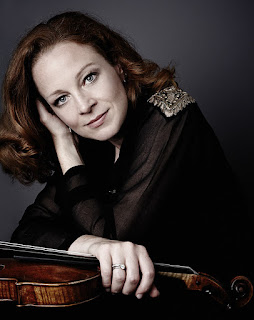The Coriolan Overture (Beethoven)
Violin Concerto No. 2 (Widmann)
Symphony No. 6 (Beethoven)
Carolin Widmann (violin)
Daniel Harding (conductor)
4 October 2018
Overture to 'Beatrice and Benedict' (Berlioz)
Piano Concerto No. 2 (Prokofiev)
Symphony No. 7 (Beethoven)
Igor Levit (piano)
Thomas Hengelbrock (conductor)
I never learn from the past and still attended the concert under jet lag. A strong coffee would have been useful to stay awake than dosing off. Nevertheless, the first concert experience at Paris Philharmonie was not that satisfying and there were some noticeable hiccups. The orchestra gave an explosive start in Beethoven's Coriolan overture. It carried the intensity to drive the tension in full until descend to a quiet end.
Widman's second violin concerto began with a minimalist gesture by using 'cor legno', which used the back of the bow hitting the strings. Short random notes made further abstract impression and then disrupted by a violent crescendo from the lower strings.
Harmonics were employed to start the second movement mysteriously in a surreal timeless landscape. A more lyrical line for the violin to indulge on lush romantic themes but the orchestral accompaniment was atonal on the other hand. It carried more emotional towards the end of the movement in a bright and raw tone.
An energetic charge kicked off the last movement with a busy part for the solo violin. It quoted the beginning of the concerto briefly before bursting in hurry again. The nervousness and violence built towards a bizarre and explosive coda like a boiling kettle.
In the Beethoven's sixth symphony, Daniel Harding's big gesture conducting style seems to be in opposite of the orchestra's playing being elegant and fluid. He made noticeable groans that one felt rather disturbing for the audio appreciation. The arpeggios were kept light and displayed the colourful scoring effectively of a cheerful pastoral scene in the first movement. The second began tenderly with the strings playing with mute on. It created a raindrop impression while keeping the music flowing softly. The wind solos were sweet in tone and able to show the dynamic contrast. Though the dialogue between the flute and clarinet went rather wrong that it took some bars to rectify and get back together.
The gallop before the storm was better coordinated that sustained the rhythmic forwardness. It reached sheer intensity at the stormy passage which was dramatically rendered and again displayed the contrast in colours and dynamics. A rather swift tempo was adopted for the aftermath fifth movement, which Harding probably preferred as a light quick dance. It certainly kept the momentum flowing and very bright colour from the brass. The coda was regal and stately concluded.
Hengelbrock's conducting was different from Harding by being less expressive and controlling. Yet there was some uncertain moments in Berlioz's overture that he let the orchestra to lead the direction. The playing at first lacked the swing of a dance but the strings played the lyrical theme beautifully. Bright tone during the gallop and the tutti playing gained more forward momentum. It finished energetically with sheer excitements.
Structurally Prokofiev's second piano concerto was more upheaval and stormy than the third piano concerto. A dreamy start to the first movement by the solo piano negotiating between ebbs and flows of subtle emotions. The virtuosic passage was a flamboyant dance attempted to break the mysterious atmosphere before retreating again. The quietness created a blurry coastal scene afar that echoed the calm beginning. It was disrupted by the orchestra thundering entry. In contrast to the tender touch before, Levit added more weight and intensity to build up the crescendo throughout the symphonic like solo passage.
The second movement was more straightforward for the audio appreciation with the music galloping in haste and rhythmically energetic. Like many other works by Prokofiev, the dotted rhythm dance gave a more muscular and weighty impression to the third movement. It was like a drunken Russian dance that swung bizarrely to a violent climax, yet not grotesque or sarcastic. The coda was surreal and dreamy again with soft chords on the solo piano. Levit sustained the curiosity with delicate touch and clarity in his playing.
 A dramatic beginning to the last movement alike a beast storming in and showing emotions in full. It was answered by a quiet passage that recalling an old Russian folk tune in tenderness, which Levit kept the legato sustained for a long line. Though the violent presto did not leave much room to indulge on emotions, instead sheer wildness and madness marked the conclusion.
A dramatic beginning to the last movement alike a beast storming in and showing emotions in full. It was answered by a quiet passage that recalling an old Russian folk tune in tenderness, which Levit kept the legato sustained for a long line. Though the violent presto did not leave much room to indulge on emotions, instead sheer wildness and madness marked the conclusion.The hall acoustic enhanced the textural clarity and dynamic contrast in one of the all time favourites, Beethoven's seventh symphony. A subtle opening followed by a majestic and robust gallop to the first movement. Dramatically it was exciting and rhythmically energetic. Hengelbrock employed a rather swift tempo for the second movement and shaped the music like a dance. Rhythmically active and carried less musical sentiments. The winds' solo lines flowed into one another seamlessly and effective in dynamic contrast.
Energetic gallop opened the third movement that sustained the forward momentum and kept the music flowing. Even at quick tempo, the dynamic difference was observed and not losing the activeness in sound. The brass played the fanfare in bright tone and triumphantly. It continued into the flamboyant dance of the fourth movement with no gap. Tempo was on the swift side that carried a lot of energy into the gallop. It built up to an explosive climax at the conclusion and the strings enjoyed the dialogue among parts, which without surprise earned an enthusiastic reception from the audience.
(Photo credit: Orchestre de Paris)





